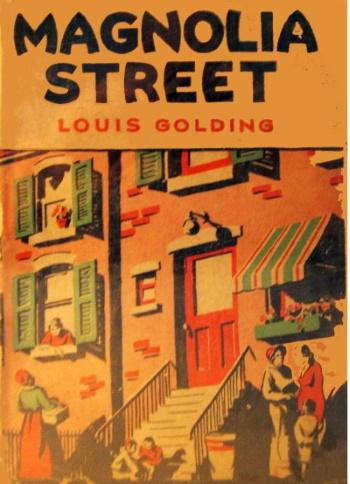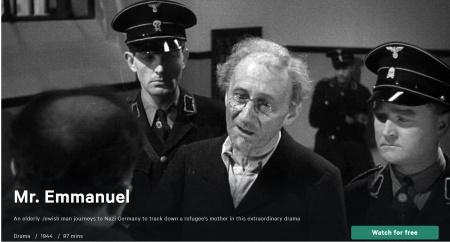
Book review by George S.: Magnolia Street is rather like two later books, Howard Spring's Manchester saga, Fame is the Spur, and Walter Greenwood's Love on the Dole (set in Salford), in that it has a large cast of characters, mostly presented in a Dickensian way, with each of them given some striking and memorable characteristics, so that we remember each of them as their stories weave together. But where the crucial topic of Spring and Greenwood is class relations, Golding's key subject is race. Magnolia Street is in a working-class district in North Manchester. One side of the street (the odd numbers) is Jewish, while the even-numbered houses are inhabited by gentiles. The novel follows the fortunes of the street's residents from 1910 to 1930.
Apparently, Magnolia Street is closely based on Sycamore Street, where Golding grew up, in Hightown, near Cheetham Hill, a district whose Jewish community had increased during the nineteenth century. (Sycamore Street was demolished in the slum clearances of the 1960s, and now the area is more notable for containing communities of later immigrants.)
In 1910, when the novel begins, there is a tension between the two halves of the street. They prefer not to mix, but relations only become actually unpleasant on the nights when one of the gentile families, the Derricks, throw one of their regular parties, which always end up with some of their guests yelling 'Who killed Christ?' across the thirty feet that separate the two rows of houses. This behaviour greatly embarrasses most of the other gentile families.
The book is very anecdotal. Each chapter tells an incident in the life of one character or family, though other stories may be woven into it its narrative too. Some of the chapters could stand as stories in their own right, and it's no surprise that the book seems to have begun as a series of sketches, published in the Manchester Guardian and elsewhere. Golding is a leisurely author, who from time to time addresses the reader directly: 'Let us cross the roadway with Mrs Briggs to the gentile pavement of Magnolia Street.'
The first chapters deal especially with scandal caused by the romance between Rose Berman, from the Jewish side of the street, and John Cooper, a sailor whose family live on the other side. The main obstacle to their union is Rose's fear of how a mixed marriage would upset her fragile mother (The Jews are presented as more firmly opposed to mixed marriages than are the gentiles.) This plot remains unresolved when a dramatic incident happens. A young Jewish man saves a gentile boy from drowning. This is a cause for general celebration, and gives an opportunity to one of the book's most sympathetic characters, Mr Emmanuel, an idealist who wants to bring the two sides of the street together. He organises a large party whose crowning moment will be the presentation of a gold watch to the Jewish hero. These chapters show Golding's comic talents, as Mr Emmanuel's noble but rather naïve plans come up against human nature in various forms. The celebration party is something of an embarrassing disaster, but it does do something to bring the two sides of the street together.
A key theme of this part of the book is the exploration of various attitudes towards Jewish identity, from the rabbi whose whole life is the exploration of ancient biblical texts to the young people who cannot wait to leave and discover a larger world elsewhere.
The second part of the novel jumps forward to 1916, though it includes much looping back to catch-up on what has happened in the intervening years. The most important event, of course, has been the outbreak of war, and Golding, who had himself served with the Friends Ambulance Unit in Salonika and elsewhere, tracks how war affects the lives of Magnolia Street. He does not tell stories of fighting, for reasons that he explains:
The tale of the soldiers, on the other hand, and all those direct participators [...] has darkened more paper than any theme in human history, saving the Bible, perhaps. There is something of futility in all that monumental writing and reading. It is as if a man were to lift a bucket and another bucket and another bucket out of the ocean, to show how deep it is. It will never be computed to what heights men soared and to what depths they sank, what woe they endured, during those years.
Golding calls his own endeavour 'a humble one': to answer the question
What in our small street, did they feel when the soldiers went from their sides, the women, the old men, the children?
Some of the effects of war are predictable. The horrible Mrs Derricks, who had led the shouting of 'Who killed Christ? 'becomes a giver out of white feathers, and starts an attack on a gentile woman who had been born in Germany. Golding shows boys who enlist under-age, and a man who lives hidden in a coal-cellar rather than go and fight. The local thief wins the D.C.M., while a young man with fantasies of social advancement is court-martialed. One of the least likely of the street's girls gives birth to a war baby. Several men are damaged and some are killed. The leisurely pace of the first half of the book has enabled us to know these characters pretty well, for better or for worse, so that the unfolding of their reactions to the war is more effective than if the novel had just been a war book.
The third section jumps forward to 1930, when one of the rabbi's sons has won a boxing match in Madison Square Gardens, to become World Lightweight champion. He sails home with the plan of holding another party, a homecoming celebration to which once again, all of Magnolia Street will be invited. This gives Golding a chance to catch up on the stories of his people. Some have had spectacular success, some have failed, and several have become stuck in routines from which they cannot escape. Golding invites the reader to walk through the familiar street 'like a ghost', remembering the street's past nostalgically, but not feeling part of it - which was Golding's own position by 1930, since he had spent most of the twenties abroad.
The book was a major best-seller in 1932, and I can see why. Not only does it give us an insight into the life of the Jewish community, but it conveys a Golding's enjoyment of the quirks of humanity, and his idealism, which is like Mr Emmanuel's but with a firmer sense of the awkwardness of human nature. Comfortingly, it suggests that by 1932 Anti-Semitism is lessening in England, whatever might be happening in Berlin of Vienna. Golding wrote several other books set in Magnolia Street district, most notably Mr Emmanuel, (1939) which became a film in 1944. It tells the story of how the unworldly Mr Emmanuel goes to Nazi Germany in the late thirties, in the hope of finding the mother of a young refugee whom he has befriended. The film can be found on the BFI website:
https://player.bfi.org.uk/free/film/watch-mr-emmanuel-1944-online
